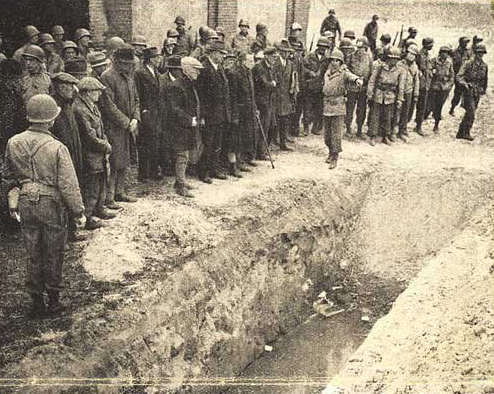
| Burgomeisters of Kreis
Gardelegen view the mass grave from which over 700 burned bodies
were later removed. |
Once again SS boys ignited the floor,
this time keeping the prisoners away from the fire by throwing
hand grenades into the frantic masses. Exploding grenades spread
the flames. At one door, where stubborn prisoners beat out the
fire several times, a burp gun ripped into the struggling groups
and signal flares reignited the floor. Finally, satisfied that
the flames were out of control, the big doors were closed and
barricaded.
Gaza, huddled in a corner was digging
a hole under a door. Others tried to do the same. One managed
to get his head through the opening before he died. But Gaza
was lucky. He, his comrade, and a Pole, dug for an hour before
they had a tunnel big enough. The Pole went out first. It was
then about nine oclock and getting dark. If they could reach
to the corner they might escape by crawling through the grain
fields to the north. Just as the Pole reached the corner, a dog
came sniffing by. The Pole tried to control his quaking limbs
and feign death. But the dog howled, and a guard came running.
A bullet freed the Pole from his troubles.
Behind him lay Gaza grimly awaiting his
turn. Again he was lucky. Dog and master returned to the opposite
side of the barn.
Gaza and his comrade crawled two miles
to a damaged farm house.
Another man, a Frenchman, managed to
remain alive in the burning barn. Sheltered by a mass of burned
bodies he somehow escaped suffocation. He later told that SS
men returned in the morning, calling that they were ready to
give medical aid to anyone who had lasted the night. Several
survivors indicated that they were alive. They were shot on the
spot.
Local slave laborers were rounded up Saturday morning to dig
great trenches around the barn, bury the remains, and otherwise
clean up the evidence. Over 700 bodies were concealed before
this work was interrupted by the surrender of the town.
Under the stern supervision of the 102d
Infantry Division, burgomeisters from neighboring towns were
conducted to the barn where they viewed the still smoldering
victims of their criminal Nazi regime. They were charged with
the responsibility of telling their communities the sordid tale.
Later the citizens of Gardelegen established a memorial cemetery
near the building. All able-bodied men of the community assisted
in burying the dead and each family is henceforth responsible
for keeping a grave forever green.
|